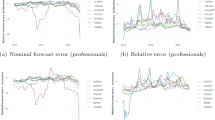Abstract
Whether including monetary aggregates and different financial variables into small scale BVAR models improves the accuracy of output forecasts is tested for three emerging European economies. Various specifications for the priors of the BVAR models are used. The results are found to vary with respect to prior specification, variables, as well as prediction horizon. The evidence is stronger when the forecasting accuracy is compared based on log predictive likelihood but weaker when the RMSEs are used. These results may constitute evidence against dismissing the monetary aggregates or financial variables as completely irrelevant.
Similar content being viewed by others
References
Banbura M, Giannone D, Reichlin L (2010) Large Bayesian vector auto regressions. J Appl Econom 25(1):71–92
Berger H, Österholm P (2009) Does money still matter for US output? Econ Lett 102:143–146
Canova F, Menz T (2011) Does money matter in shaping domestic business cycles. An international investigation. J Money Credit Banking 43(4):577–607
Canzoneri M, Cumby R, Diba B, Lopez-Salido D (2008) Monetary aggregates and liquidity in a Neo-Wicksellian framework. J Money Credit Banking 40(8):1667–1698
Castelnouvo E (2012) Estimating the evolution of money’s role in the US monetary business cycle. J Money Credit Banking 44: 23–52
Christiano LJ, Ljungqvist L (1988) Money does Granger-cause output in the bivariate money-output relation. J Monet Econ 22:217–235
D’Agostino A, Surico P (2009) Does global liquidity help to forecast US inflation? J Money Credit Banking 41(2–3):479–489
De Mol C, Giannone D, Reichlin L (2008) Forecasting using a large number of predictors: is Bayesian regression a valid alternative to principal components? J Econom 146:318–328
Diebold FX, Mariano RS (1995) Comparing predictive accuracy. J Bus Econ Stat 13:253–265
Doan Th, Litterman R, Sims Ch (1984) Forecasting and conditional projection using realistic prior distributions. Econom Rev 3(1):1–100
Espinoza R, Fornari F, Lombardi MJ (2012) The role of financial variables in predicting economic activity. J Forecast 31:15–46
Favara G, Giordani P (2009) Reconsidering the role of money for output, prices and interest rates. J Monet Econ 56:419–430
George E, Sun D, Ni S (2008) Bayesian stochastic search for VAR model restrictions. J Econom 142:553–580
Geweke J, Amisano G (2010) Comparing and evaluating Bayesian predictive distributions of asset returns. Int J Forecast 26(2):216–230
Koop G, Korobilis D (2010) Bayesian multivariate time series methods for empirical macroeconomics. Found Trends Macroecon 3(4):267–358
Korobilis D (2013) VAR forecasting using Bayesian variable selection. J Appl Econom 28: 204–230
Litterman RB (1981) A Bayesian procedure for forecasting with vector autoregressions. Working Paper, Federal Reserve Bank of Minneapolis
Litterman R (1986) Forecasting with Bayesian vector autoregressions: five years of experience. J Bus Econ Stat 4(1):25–38
Panopoulou E (2007) Predictive financial models of the euro area: a new evaluation test. Int J Forecast 23(4):695–705
Rapach DE, Weber CE (1985) Financial variables and the simulated out-of-sample forecastability of US output growth since 1985: an encompassing approach. Econ Inq 42(4):717–738
Ravn MO, Psaradakis Z, Sola M (2005) Markov switching causality and the money–output relationship. J Appl Econom 20:665–683
Sims CA (1972) Money, income, and causality. Am Econ Rev 62:540–552
Sims CA (1980) Macroeconomics and reality. Econometrica 48:1–48
Sims CA, Stock JH, Watson MW (1990) Inference in linear time series models with some unit roots. Econometrica 58:113–144
Stock JH, Watson MW (1989) Interpreting the evidence on money-income causality. J Econom 40:161–181
Stock JH, Watson MW (2003) Forecasting output and inflation: the role of asset prices. J Econ Lit 41:788–829
Tomsik V, Viktorova D (2006) The relationship between money and output in the Czech Republic. Evidence from VAR analysis. East Eur Econ 44(2):23–39
Woodford M (2003) Interest and prices: foundation of a theory of monetary policy. Princeton University Press, Princeton, NJ
Acknowledgments
This study was supported by CNCSIS—UEFISCSU, Project Number PNII—RU 25/5.08.2010.
Author information
Authors and Affiliations
Corresponding author
Appendices
Appendix A: RMSEs for Koop and Korobilis (2010) approach
See Tables 17, 18, 19, 20, 21, and 22.
Appendix B: RMSEs for Banbura et al. (2010) approach
See Tables 23, 24, 25, and 26.
Rights and permissions
About this article
Cite this article
Caraiani, P. Do money and financial variables help forecasting output in emerging European Economies?. Empir Econ 46, 743–763 (2014). https://doi.org/10.1007/s00181-013-0686-5
Received:
Accepted:
Published:
Issue Date:
DOI: https://doi.org/10.1007/s00181-013-0686-5




